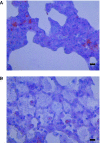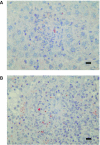Q fever pneumonia: virulence of Coxiella burnetii pathovars in a murine model of aerosol infection
- PMID: 15784593
- PMCID: PMC1087393
- DOI: 10.1128/IAI.73.4.2469-2477.2005
Q fever pneumonia: virulence of Coxiella burnetii pathovars in a murine model of aerosol infection
Abstract
Q fever is a worldwide zoonosis caused by Coxiella burnetii, a strictly intracellular bacterium that is a potential bioweapon. Humans usually acquires Q fever after inhalation of dust infected by subclinical animals. We used an aerosol exposure apparatus to challenge immunocompetent (BALB/c) and severe combined immunodeficient (SCID) mice with two different strains (strain Nine Mile and strain Q 212) of C. burnetii at two different inocula. Pathological lesions and dissemination of the bacteria were related to the size of the inoculum. SCID mice showed major pulmonary lesions, whereas similarly infected BALB/c mice were more able to eliminate the bacteria. Pathological differences were found between the strains, with Nine Mile showing more severe histological lesions and quantified spread of bacteria. Our animal model could provide a new tool for the study of acute Q fever pneumonia, the development of Q fever in immunodeficient hosts, and the differentiation of pathogenicity among C. burnetii isolates.
Figures





References
-
- Anonymous. 1950. Experimental Q fever in man. Br. Med. J. 1:1000.
-
- Babudieri, B. 1959. Q fever: a zoonosis. Adv. Vet. Sci. Comp. Med. 5:82-182.
-
- Embil, J., J. C. Williams, and T. J. Marrie. 1990. The immune response in a cat-related outbreak of Q fever as measured by the indirect immunofluorescence test and the enzyme-linked immunosorbent assay. Can. J. Microbiol. 36:292-296. - PubMed
MeSH terms
Substances
LinkOut - more resources
Full Text Sources

